A typical Dealer Management System (DMS) addresses diverse requirements encompassing pivotal areas like pre-sales (lead/enquiry management), sales, purchasing, service/after sales, inventory management, financial accounting, HR and CRM. It connects OEMs and companies, distributors, dealers and customers, providing a flawless and enriched operational experience. A DMS is a dealers’ ERP, enabling dealerships to perform their day-to-day operations effectively.
A DMS is going to be an important entity in the supply chain landscape because traditional dealerships will continue to be important in the coming decade. According to a survey by EY in Germany for automotive dealers:
Amongst automotive customers, the first visit (to the dealership) is the most crucial where the role of sales personnel is very prominent.
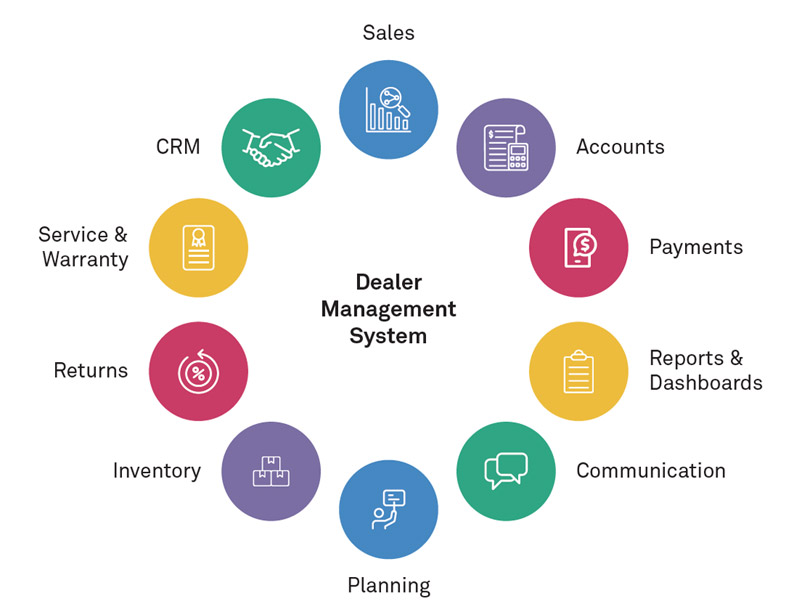

Data source: https://www.ey.com/Publication/vwLUAssets/ey-automotive-retail-2030/$File/ey-automotive-retail-2030.pdf
For many customers, dealerships will still provide additional information, which is difficult to get online. This clearly indicates that dealerships are going to be one of the mainstays of the supply chain ecosystem, and hence the need for a digital system to manage them.
Starting from decentralized thick clients and maintaining heterogeneous systems to centralized DMS applications, Dealer Management Systems have come a long way since they started being popular in the early-nineties and have now become an integral part of the supply chain network.
Dealers and distributors in most industries (auto, manufacturing, retail, telco, etc.) will all have some form of a DMS.
Being one of the oldest to experiment and implement Dealer Management Systems, Wipro has rich experience in implementing complex yet successful DMS for automotive, telecom and retail companies across the globe.
Need for a paradigm shift
Advancement in technology supported by changes in government rules and policies, and ever-changing consumer behavior have opened doors for multiple and specialized ways of connecting with customers and delivering the required products/services. This has created multiple levels of challenges in the supply chain ecosystem in manufacturing, consumer goods and automobile sectors globally and locally.
These growing challenges have given rise to the requirement of dedicated Next-Generation Dealer Management Systems (Next-Gen DMS).
Following are some of the recent industry use-cases that underscore the need for a Next-Gen DMS.
Extending network
A leading paint manufacturing company has been using a DMS for their distributors across multiple countries since the last few years. This DMS is for their distributors and now they want to extend to the leaf nodes of their supply chain i.e. dealers and retailers.
Requires manufacturer to procure another kind and set of licenses since the existing licenses are of different modules. The manufacturer envisages huge cost of licenses in doing this, and this becomes a major bottleneck.
Functional & Technical Scalability
A large passenger car manufacturing company is already using a DMS that has been in use for a few years now. Per business demands, several changes/ enhancements are required.
Legacy technology and end-of-life hardware make it very difficult (and costly) to make a small change in this DMS.
Capital Investment
An automotive leader in India is using a decade-old DMS and spending hugely on recurring licenses. Usability issues, performance and customer experience demands an upgrade of its DMS and system software.
Upgrading the solution requires huge capital investment on license and infrastructure, yet does not promise the experience and scalability of modern cloud-native applications.
Accessibility
A major tractor manufacturer is using a DMS hosted on their premises. During the festive seasons and month/year end, there is heavy rush and dealers face performance issues on-premise setup accessible over WAN.
Lack of mobile apps and anytime-anywhere access creates a challenge for the field force and restricts operational capabilities of dealers.
Trends in DMS
Although dealer management systems have matured over the years, following are some trends in the DMS space that will drive them forward in the next phase:
These emerging trends are causing dealers and OEMs to rethink their current dealer management solutions and undergo a significant transformation in order to remain relevant and viable over the next decade.
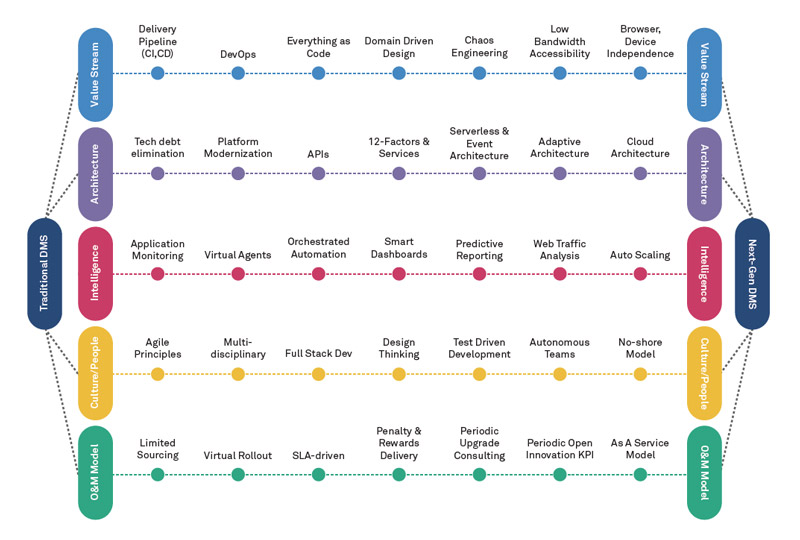
Dealership Platform Ecosystem
Per a McKinsey study, dealerships (or OEMs) of the future will be investing heavily in creating a platform ecosystem that sticks, led by various partnerships and integrating systems. This will engage the customers seamlessly in online and offline interactions, and push dealerships to think of a variety of offerings.
It has become a necessity to increase the customer’s loyalty and wallet share.
This can be made possible by increasing high-frequency customer touchpoints across the lifecycle and by creating a ‘stickier’ environment. Developing stronger customer relationship models and understanding the customer in a 3600 manner, creating personalized offerings for customers based on their loyalty, providing a seamless service process, insurance management, seamless parts-ordering and logistic experience are some of the ways by which this can be achieved.
Exceptional Customer Experience
The term ‘Customer’ refers not only to the end purchaser who owns the product, but also to the users of the DMS application i.e. the dealers. Providing exceptional customer experience is of prime importance for the Next-Gen DMS. Providing a system which has all the functionalities relevant to them with uninterrupted ‘anytime, anywhere’ access will be critical. User-friendly applications with easy navigation, ease of performing operations and ease of getting help whenever required will provide a Next-Gen DMS with an edge.
An issue or task-based help menu should be provided whenever a user faces an issue.
Integration with smart assistants such as Alexa and Siri will not only help the dealer but also their customers by making it possible to schedule appointments and know the status of their vehicle under service. Use of virtual reality for test drives and augmented reality for remote repairs are already making waves.
According to another survey by McKinsey that explores more of customer experience:
"Among customer journeys, service experience is more influential than purchase experience”
This delivers an important insight that servicing of a car is more important for the customer rather than purchasing it. This is true especially with the next generation of customers who are digitally more aware.
If the traditional time taking and low customer delight areas like service booking or appointment, vehicle pickup and drop, transparency in service completion status, estimated cost, online payment through wallets or cards, customer feedback, etc. can be digitally simplified, then it will definitely provide a good customer experience.
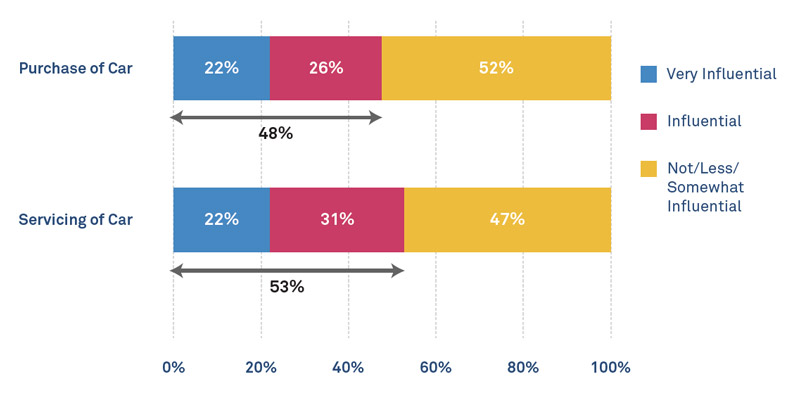
Connected & Autonomous Cars
The next decade will be of connected cars and autonomous cars. With the advancement in IoT, sensors and machine learning, it is now possible to obtain vehicle data remotely, opening up new ways of operating automobiles. A DMS can now provide vehicle details in terms of actual mileage, kilometres run, performance of the vehicle, issues if any, etc. through such sensors, assisting technicians in analyzing vehicles in lesser time.
This becomes more important in situations where many vehicles are pending for repairs and technicians need to finish their work as soon as possible (e.g. opening the dealership after a long period of lockdown/ holidays). The Next-Gen DMS should be compatible with these IoT devices and sensors, and should make use of the data received from these devices to ease the life of dealers.
Flexibility for Stakeholders
With constantly changing technology, regulations, market conditions and other factors, new stakeholders/influencers/other vendors are arising, and it becomes important to align them with the existing supply chain. The Next-Gen DMS should be flexible enough to accommodate them with less effort.
Analytics-based (data-driven) Decisions
The Next-Gen DMS should use the power of data not just from within but from the external system and social media as well. It should help showroom sales executives in closing deals and service advisors in predicting vehicle/product failure. AI-based analytics can help with this.
Learning Management Solution
Most traditional DMS applications are not ticking all the boxes especially when it comes to training, learning management and other HR capabilities. Since the market dynamics are constantly changing, it is important to have a technically and functionally updated dealership workforce. The Next-Gen DMS should provide dealerships and their workforce the facilities to share their training/learning needs, to attend courses and evaluations to keep them updated in various aspects of their jobs.
Connected Applications
Uninterrupted and seamless access of the DMS and many related and dependent applications will also be very important.
With increasingly niche technology solutions like GPS, e-commerce, IoT, learning management, analytics, artificial intelligence and mobility, it is mandatory to use these technologies in the DMS ecosystem for various purposes and from various geographical locations. For e.g. from the comfort of a home to a noisy traffic situation. Hence, seamless integration with these technologies/applications and uninterrupted access to them will be mandatory.
Headless DMS
As mentioned earlier, the ‘anytime-anywhere’ access to the DMS is mandatory. Considering the advancement in mobility of other devices, it is very difficult to predict the form factor. Adapting to a Headless Architecture will ensure that the Next-Gen DMS suits any form factor since the backend is detached from the frontend.
Support
Robust and uninterrupted support to the dealerships and their users will also be of very critical importance. A traditional helpdesk may not be useful and may have constraints in terms of time, availability, cost, geography, etc. Leveraging AI-based chatbots for answering user queries and resolving many automated tasks will ease the pressure on the frontline helpdesk employees.
Less Time to Go to Market
It is expected that a Next-Gen DMS should be up and ready in a fraction of the time taken today and should leverage configurations over customizations.
Compliance
Adhering to various compliances and standards will also be equally important for a successful DMS application. Next-Gen DMS applications must comply with standards like local taxation, GDPR and other local standards and policies.
The Wipro Vision of a Next-Gen DMS
Wipro has been in the Dealer Management System space since the late 1990s and is the proud creator of Wipro DMS 1.0, which has been successfully implemented at many automotive and telecom companies.
Having extensive experience in the DMS ecosystem, we envisage the following tenets for a Next-Gen DMS or DMS 2.0.
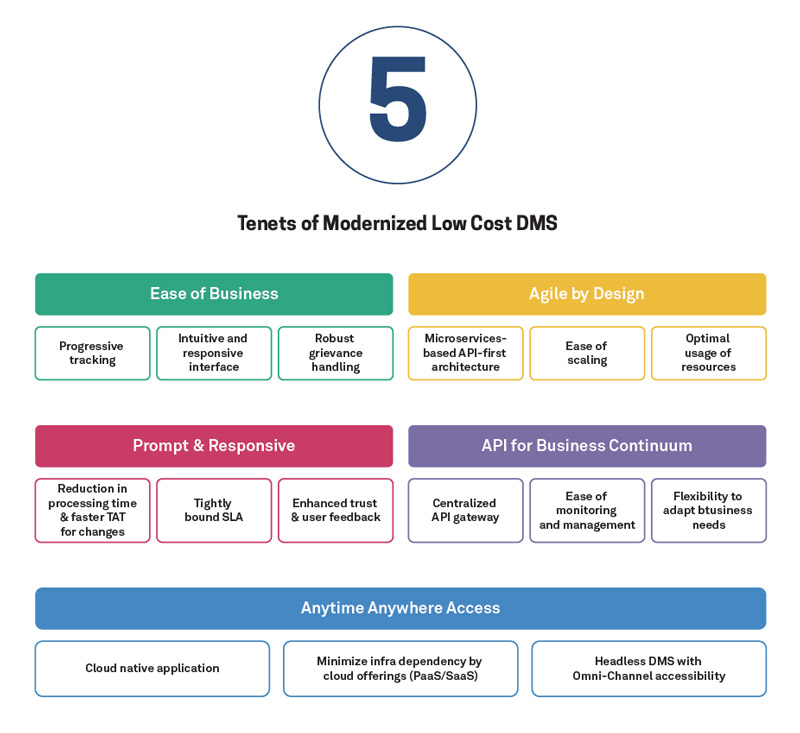
1. Ease of Business
A Next-Gen DMS must provide the various functionalities required by OEMs and companies and their supply chain partners. The solution should cater to the need of each stakeholder in the supply chain, which ultimately provides the ease with which business can be done. In most cases, a tailor-made bespoke solution is required to meet a customer’s expectations.
2. Agile by Design
A Next-Gen DMS should also be scalable in terms of accommodating more number, types of users and business requirements.
It should be flexible and agile by design. In a few recent cases, we found that the existing DMS are not scalable enough in these aspects so this becomes a major drawback. The microservices-based API-first architecture can help in attaining these goals.
3. Prompt and Responsive
Traditional dealer management solutions take years to build trust with users. A new-age DMS should provide various means of connecting with its users and hence provide faster resolutions to their issues. Faster go-to-market and TAT for any change will help OEMs implement business requirements with ease, which in turn increases the level of trust.
4. API for Business Continuum
There are several peripheral apps that either need data from the DMS or share their data with the DMS. Various ERP applications, CRM applications, mobile apps, IoT applications, warranty systems, loyalty management systems, etc. exchange data with dealer management solutions. The centralized API gateway provides the flexibility to connect easily with such apps per business requirements. It also makes monitoring and management easier.
5. Anytime Anywhere Access
Omni-channel presence is the need of the hour and like other solutions, it is a must for DMS applications as well. For instance, when a dealer management system is being accessed from the remotest areas of the country, where connectivity remains a challenge, it is imperative to access the application through various form factors, especially from mobile devices where offline access can be made available easily.
Adopting to cloud will ensure seamless connectivity with minimum downtime. With these tenets in mind, Wipro is designing a DMS 2.0 solution. The illustration below provides a glimpse of the functional architecture put forward for the inception of a Next-Gen DMS.
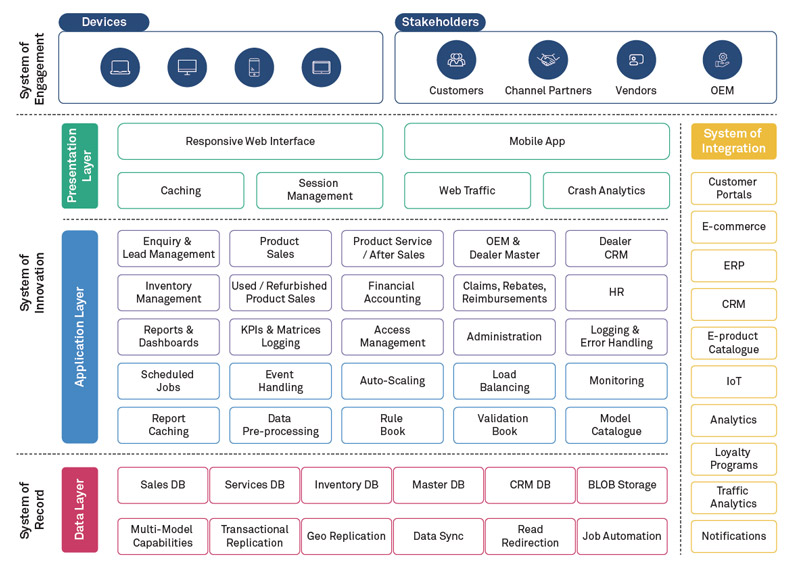
The role of dealerships in the success of enterprises is unquestionable. Wipro’s Next-Gen DMS is envisaged to make the DMS truly digital and connected in order to serve its true purpose of enabling dealers to manage their entire business from a single platform. At the same time, the role of digital will also increase as technology flourishes and the supply chain industry continues to enhance customer experience for new as well as used products.
Wipro’s DMS 2.0 is designed to be the core of the supply chain and keep pace, innovate and enhance to meet changing customer demands and business strategies, and will prove to be a true Next-Gen DMS.
Pradeepsinh Rathod
Pradeep is a consultant with over 14 years of experience in the dealer management space. He leads the DMS and mobility initiative for Modern Application Services at Wipro India. Pradeep has worked on many large dealer management projects as a business analyst. He is also experienced in implementing dealer management solutions at dealerships and understands dealers’ operations.
Amin Rehman
Amin is a Senior Solution Architect with over 13 years of industry experience. He leads the presales and practice for Customer Experience projects for Modern Application Services at Wipro India. A developer at heart, Amin enjoys designing digital and cloud-native solutions for his customers.